Pricing Guides & Dictionary of Makers Marks for Antiques & Collectibles

A few examples of appraisal values for
UNION LEAGUE
Search our price guide for your own treasures
-
 Joseph Pennell etching, The Union
Joseph Pennell etching, The Union League, Broad Street Philadelphia, pencil signed 23" x 17.5" ss / 31" x 25" oa Condition: Good, not examined out of frame.
Joseph Pennell etching, The Union
Joseph Pennell etching, The Union League, Broad Street Philadelphia, pencil signed 23" x 17.5" ss / 31" x 25" oa Condition: Good, not examined out of frame. -
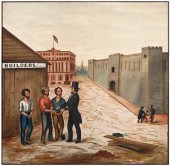 Philadelphia Union recruiting
Philadelphia Union recruiting screen, three unemployed men receiving money from a man in coat and top hat, prison and federal building in background at right, young man caught in the act of pickpocketing, possibly Fairmont Prison, Philadelphia, Pennsylvania, oil on canvas, attributed to William Eastlack, American, late 19th century, 48 x 48 in.; lattice wood frame. Cotton screen laid down on muslin, nail holes along edges, some stains, grime.
Philadelphia Union recruiting
Philadelphia Union recruiting screen, three unemployed men receiving money from a man in coat and top hat, prison and federal building in background at right, young man caught in the act of pickpocketing, possibly Fairmont Prison, Philadelphia, Pennsylvania, oil on canvas, attributed to William Eastlack, American, late 19th century, 48 x 48 in.; lattice wood frame. Cotton screen laid down on muslin, nail holes along edges, some stains, grime. -
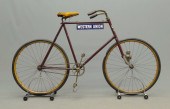 C. 1895 Western Union Sturmer men's
C. 1895 Western Union Sturmer men's pneumatic. With lamp catalog copy and western union sign. Original condition.
C. 1895 Western Union Sturmer men's
C. 1895 Western Union Sturmer men's pneumatic. With lamp catalog copy and western union sign. Original condition. -
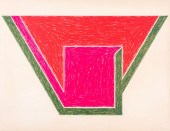 FRANK STELLA "UNION" LITHOGRAPH,
FRANK STELLA "UNION" LITHOGRAPH, 1974 Frank Stella (American, b. 1936) "Union" screenprint lithograph in colors on Arches paper, from the "Eccentric Polygons" series, 1974, pencil signed and number edition 28 of 100 lower right with blindstamp, printed and published by Gemini G.E.L., Los Angeles. Image: 17.25" H x 22.5" D; frame: 19.25" H x 24" W. Provenance: From an Upper East Side townhouse.
FRANK STELLA "UNION" LITHOGRAPH,
FRANK STELLA "UNION" LITHOGRAPH, 1974 Frank Stella (American, b. 1936) "Union" screenprint lithograph in colors on Arches paper, from the "Eccentric Polygons" series, 1974, pencil signed and number edition 28 of 100 lower right with blindstamp, printed and published by Gemini G.E.L., Los Angeles. Image: 17.25" H x 22.5" D; frame: 19.25" H x 24" W. Provenance: From an Upper East Side townhouse. -
 MILWAUKEE URBAN LEAGUE BASEBALL
MILWAUKEE URBAN LEAGUE BASEBALL TEAM PHOTOGRAPH 19301930 Milwaukee Urban League Baseball Team. Negro league baseball. Inscribed in negative along the lower right corner "Taylor Made." The jerseys with monograms with letters MUL. Stamped along the verso "J. Harry Taylor & Son, Inc., Photographers, Printed Aug 19, 1930, Milwaukee." Provenance: Property from the distinguished collection of Mr. James Lee Soffer, Pittsburgh, Pennsylvania. Height: 8 in x width: 10 3/4 in. Condition: Please contact us for a detailed condition report. Please note that the lack of a condition statement does not imply perfect condition. Email condition@revereauctions.com with any condition questions.
MILWAUKEE URBAN LEAGUE BASEBALL
MILWAUKEE URBAN LEAGUE BASEBALL TEAM PHOTOGRAPH 19301930 Milwaukee Urban League Baseball Team. Negro league baseball. Inscribed in negative along the lower right corner "Taylor Made." The jerseys with monograms with letters MUL. Stamped along the verso "J. Harry Taylor & Son, Inc., Photographers, Printed Aug 19, 1930, Milwaukee." Provenance: Property from the distinguished collection of Mr. James Lee Soffer, Pittsburgh, Pennsylvania. Height: 8 in x width: 10 3/4 in. Condition: Please contact us for a detailed condition report. Please note that the lack of a condition statement does not imply perfect condition. Email condition@revereauctions.com with any condition questions. -
 CERCLE DE L'UNION
CERCLE DE L'UNION ARTISTIQUECercle de l'Union Artistique , 1884 program, lithograph, 11 in. x 8 1/2 in Provenance: Property of the Mobile Museum of Art, Mobile, AL, sold to benefit their Collections, Care and Acquisitions Fund.
CERCLE DE L'UNION
CERCLE DE L'UNION ARTISTIQUECercle de l'Union Artistique , 1884 program, lithograph, 11 in. x 8 1/2 in Provenance: Property of the Mobile Museum of Art, Mobile, AL, sold to benefit their Collections, Care and Acquisitions Fund. -
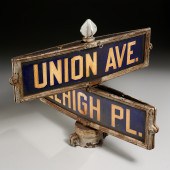 UNION AVE & LEHIGH PL
UNION AVE & LEHIGH PL INTERSECTION STREET SIGN First half 20th c., probably Irvington, NJ, double-sided metal signs bolted to intersection street post cap, 16.5"h x 20.5"w x 20.5"d
UNION AVE & LEHIGH PL
UNION AVE & LEHIGH PL INTERSECTION STREET SIGN First half 20th c., probably Irvington, NJ, double-sided metal signs bolted to intersection street post cap, 16.5"h x 20.5"w x 20.5"d -
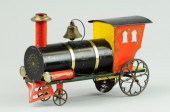 ''UNION'' CLOCKWORK LOCOMOTIVE Ives
''UNION'' CLOCKWORK LOCOMOTIVE Ives early American tin example painted in red yellow and black clockwork action cast iron spoke wheels strong stenciling reads ''Union'' on boiler. 10 1/2'' l. (Exc. Cond.)
''UNION'' CLOCKWORK LOCOMOTIVE Ives
''UNION'' CLOCKWORK LOCOMOTIVE Ives early American tin example painted in red yellow and black clockwork action cast iron spoke wheels strong stenciling reads ''Union'' on boiler. 10 1/2'' l. (Exc. Cond.) -
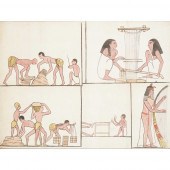 WORKING MEN’S EDUCATIONAL UNION,
WORKING MEN’S EDUCATIONAL UNION, LONDON SET OF THREE FRAMED EGYPTIAN 'DIAGRAMS', CIRCA 1855 printed and hand-coloured cotton, bears printed marks WORKING MENS EDUCATIONAL UNION/ KING WILLIAM STREET/ TRAFALGAR SQUARE/ LONDON, each later-framed, one numbered 441, 87cm x 120cm; another numbered 260, 89cm x 119.5cm; the other numbered 259, 119.5cm x 89cm(3)Note: The Working Men's Educational Union was 19th century English union, with rooms at 25 King William Street, Trafalgar Square, London. Founded in December 1851 by Benjamin Scott the union began producing 'diagrams', a series of large, coloured lithographs printed on calico, with eyelets on each corner, to illustrate lectures to their members. John Ruskin was an ardent supporter of the scheme.
WORKING MEN’S EDUCATIONAL UNION,
WORKING MEN’S EDUCATIONAL UNION, LONDON SET OF THREE FRAMED EGYPTIAN 'DIAGRAMS', CIRCA 1855 printed and hand-coloured cotton, bears printed marks WORKING MENS EDUCATIONAL UNION/ KING WILLIAM STREET/ TRAFALGAR SQUARE/ LONDON, each later-framed, one numbered 441, 87cm x 120cm; another numbered 260, 89cm x 119.5cm; the other numbered 259, 119.5cm x 89cm(3)Note: The Working Men's Educational Union was 19th century English union, with rooms at 25 King William Street, Trafalgar Square, London. Founded in December 1851 by Benjamin Scott the union began producing 'diagrams', a series of large, coloured lithographs printed on calico, with eyelets on each corner, to illustrate lectures to their members. John Ruskin was an ardent supporter of the scheme. -
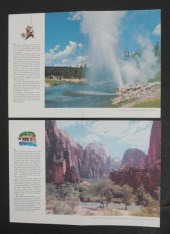 TEN UNION PACIFIC RAILROAD DINING
TEN UNION PACIFIC RAILROAD DINING CAR MENUS
TEN UNION PACIFIC RAILROAD DINING
TEN UNION PACIFIC RAILROAD DINING CAR MENUS -
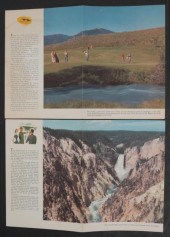 15 UNION PACIFIC RAILROAD DINING
15 UNION PACIFIC RAILROAD DINING CAR MENUS
15 UNION PACIFIC RAILROAD DINING
15 UNION PACIFIC RAILROAD DINING CAR MENUS -
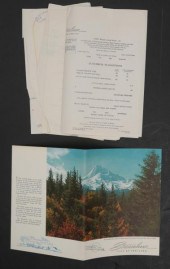 15 UNION PACIFIC RAILROAD DINING
15 UNION PACIFIC RAILROAD DINING CAR MENUS
15 UNION PACIFIC RAILROAD DINING
15 UNION PACIFIC RAILROAD DINING CAR MENUS -
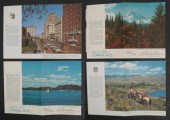 15 UNION PACIFIC RAILROAD DINING
15 UNION PACIFIC RAILROAD DINING CAR MENUS
15 UNION PACIFIC RAILROAD DINING
15 UNION PACIFIC RAILROAD DINING CAR MENUS -
 VAN MIERLE PROOST “UNION FAIT LA
VAN MIERLE PROOST “UNION FAIT LA FORCE.”Van Mierle Proost “Union Fait la Force.” Brussels, ca. 1945. 52 + J + OB. Excellent (some card faces white and some tan). Suits represent England, America, France and Russia. Kings are Churchill, Stalin, Roosevelt and Degaulle. Joker is Hitler with exploding grenade.
VAN MIERLE PROOST “UNION FAIT LA
VAN MIERLE PROOST “UNION FAIT LA FORCE.”Van Mierle Proost “Union Fait la Force.” Brussels, ca. 1945. 52 + J + OB. Excellent (some card faces white and some tan). Suits represent England, America, France and Russia. Kings are Churchill, Stalin, Roosevelt and Degaulle. Joker is Hitler with exploding grenade. -
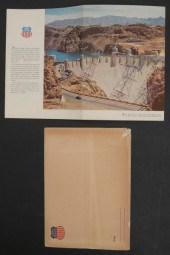 21 UNION PACIFIC RAILROAD DINING
21 UNION PACIFIC RAILROAD DINING CAR MENUS
21 UNION PACIFIC RAILROAD DINING
21 UNION PACIFIC RAILROAD DINING CAR MENUS -
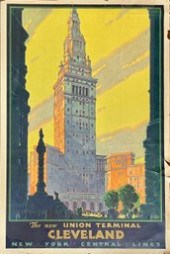 Ca. 1930 'The New Union Terminal,
Ca. 1930 'The New Union Terminal, Cleveland', lithographic railway poster, showing Tower City Center, the second tallest building in the world when built in 1930. Art by Leslie Ragan. 41” x 27” Condition: large tear to top edge extending in 15”, other tears on all edges, minor losses. CT Transfer Fee $10
Ca. 1930 'The New Union Terminal,
Ca. 1930 'The New Union Terminal, Cleveland', lithographic railway poster, showing Tower City Center, the second tallest building in the world when built in 1930. Art by Leslie Ragan. 41” x 27” Condition: large tear to top edge extending in 15”, other tears on all edges, minor losses. CT Transfer Fee $10 -
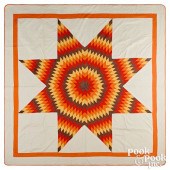 UNION COUNTY, PENNSYLVANIA LONESTAR
UNION COUNTY, PENNSYLVANIA LONESTAR QUILTUnion County, Pennsylvania lonestar patchwork quilt, early 20th c. , 88" x 90". Provenance: The Packwood House Museum. Competitive in-house shipping is available for this lot. Condition: Pencil lines visible, good condition.
UNION COUNTY, PENNSYLVANIA LONESTAR
UNION COUNTY, PENNSYLVANIA LONESTAR QUILTUnion County, Pennsylvania lonestar patchwork quilt, early 20th c. , 88" x 90". Provenance: The Packwood House Museum. Competitive in-house shipping is available for this lot. Condition: Pencil lines visible, good condition. -
 UNION COUNTY, PENNSYLVANIA TIN
UNION COUNTY, PENNSYLVANIA TIN ADVERTISING SIGNUnion County, Pennsylvania embossed tin advertising sign, ca. 1900, inscribed Sankey's Life of Leather For Sale Here - Reish & Sankey Sole Mfers, Mifflinburg, Pa. , 6 1/2" x 13 3/4". Competitive in-house shipping is available for this lot. Condition: Minor bends, small edge tear and surface loss.
UNION COUNTY, PENNSYLVANIA TIN
UNION COUNTY, PENNSYLVANIA TIN ADVERTISING SIGNUnion County, Pennsylvania embossed tin advertising sign, ca. 1900, inscribed Sankey's Life of Leather For Sale Here - Reish & Sankey Sole Mfers, Mifflinburg, Pa. , 6 1/2" x 13 3/4". Competitive in-house shipping is available for this lot. Condition: Minor bends, small edge tear and surface loss. -
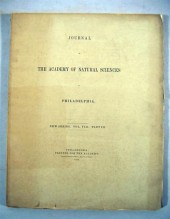 Lot. Lea, Isa Observation on
Lot. Lea, Isa Observation on The Genus Unio. Philadelphia [1842]-[1874]. Vols. 2, 3, 5, 6, 7, 8, 10, 12, 13, index to vols. 1-13, vol. 3 only; A Synopsis of The Family Unionidae, Philadelphia, 1870. 4to, printed wrappers (vols. 6, vol. 8, part 2, 12, 13, index); unbound (vols. 2, 5, 7, 8, 10, synopsis); orig. printed bds. (vol. 3). With additional copy of vol. 8, part 2. With 18 litho plates in vol. 8, part 2, 26 litho plates in vol. 12, 22 litho plates in vol. 13. Also with 101 loose litho plates for this work (Jour. Acad. Nat. Sci., 2nd Series - vol. III, plates 21-33; vol. V, plates 21-45, 51-66; vol. 5 plates 1-18, 41-50; vol. 10, plates 12-30). Also 23 related conchology litho plates. Property from the Estate of Dr. and Mrs. Meyer Naide, Philadelphia, PA Descriptions provided in both printed and on-line catalogue formats do not include condition reports. The absence of a condition statement does not imply that the lot is in perfect condition or completely free from wear and tear, imperfections or the effects of aging. Interested bidders are strongly encouraged to request a condition report on any lots upon which they intend to bid, prior to placing a bid. All transactions are governed by Freeman''s Conditions of Sale.
Lot. Lea, Isa Observation on
Lot. Lea, Isa Observation on The Genus Unio. Philadelphia [1842]-[1874]. Vols. 2, 3, 5, 6, 7, 8, 10, 12, 13, index to vols. 1-13, vol. 3 only; A Synopsis of The Family Unionidae, Philadelphia, 1870. 4to, printed wrappers (vols. 6, vol. 8, part 2, 12, 13, index); unbound (vols. 2, 5, 7, 8, 10, synopsis); orig. printed bds. (vol. 3). With additional copy of vol. 8, part 2. With 18 litho plates in vol. 8, part 2, 26 litho plates in vol. 12, 22 litho plates in vol. 13. Also with 101 loose litho plates for this work (Jour. Acad. Nat. Sci., 2nd Series - vol. III, plates 21-33; vol. V, plates 21-45, 51-66; vol. 5 plates 1-18, 41-50; vol. 10, plates 12-30). Also 23 related conchology litho plates. Property from the Estate of Dr. and Mrs. Meyer Naide, Philadelphia, PA Descriptions provided in both printed and on-line catalogue formats do not include condition reports. The absence of a condition statement does not imply that the lot is in perfect condition or completely free from wear and tear, imperfections or the effects of aging. Interested bidders are strongly encouraged to request a condition report on any lots upon which they intend to bid, prior to placing a bid. All transactions are governed by Freeman''s Conditions of Sale. -
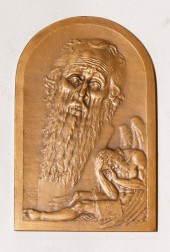 1938 BRONZE PLAQUE ?UNION OF
1938 BRONZE PLAQUE ?UNION OF FAITHS? Louis Chattel Rosenthal this medal in 1938 for Mr and Mrs Hammon Burton, of Baltimore. Obverse has multiple interpretations - the bearded man as suffering humanity or Chronos. Lower left has Rosenthal's artist signature. Reverse has three hands holding torch and below "In The Union of Faiths We are Fortified To Serve Mankind".
1938 BRONZE PLAQUE ?UNION OF
1938 BRONZE PLAQUE ?UNION OF FAITHS? Louis Chattel Rosenthal this medal in 1938 for Mr and Mrs Hammon Burton, of Baltimore. Obverse has multiple interpretations - the bearded man as suffering humanity or Chronos. Lower left has Rosenthal's artist signature. Reverse has three hands holding torch and below "In The Union of Faiths We are Fortified To Serve Mankind". -
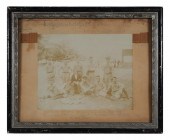 1896 BASEBALL CHAMPIONS PHOTO,
1896 BASEBALL CHAMPIONS PHOTO, LEHIGH VALLEYOriginal photograph from 1896 showing the Lehighton Baseball Club, champions of the professional Lehigh Valley League, which was in existence for only two years, 1896 and 1897. Each player, as well as the Manager Arthur Teets, is named below the photo. To each side of the image are box scores for the final game, which was played August 29th, 1896, the same day the photo was taken. The Lehigh Valley League was a non-signatory 19th century baseball league in Pennsylvania in 1896-97 operating as an unclassified organization with teams from Lehighton, Allentown, Catasauqua, Easton and Mauch Creek (now called Jim Thorpe.) Photo measures 10"x 8", framed to 15 3/4" x 13". A rare piece of early baseball history with identifying information in original period frame. Photo is in good condition, somewhat lightened. Mount has some toning. Frame is in good condition with minor wear. shipping info This item will need to be shipped by a packing company of your choice. We maintain a list of reliable shippers, or you may choose your own.
1896 BASEBALL CHAMPIONS PHOTO,
1896 BASEBALL CHAMPIONS PHOTO, LEHIGH VALLEYOriginal photograph from 1896 showing the Lehighton Baseball Club, champions of the professional Lehigh Valley League, which was in existence for only two years, 1896 and 1897. Each player, as well as the Manager Arthur Teets, is named below the photo. To each side of the image are box scores for the final game, which was played August 29th, 1896, the same day the photo was taken. The Lehigh Valley League was a non-signatory 19th century baseball league in Pennsylvania in 1896-97 operating as an unclassified organization with teams from Lehighton, Allentown, Catasauqua, Easton and Mauch Creek (now called Jim Thorpe.) Photo measures 10"x 8", framed to 15 3/4" x 13". A rare piece of early baseball history with identifying information in original period frame. Photo is in good condition, somewhat lightened. Mount has some toning. Frame is in good condition with minor wear. shipping info This item will need to be shipped by a packing company of your choice. We maintain a list of reliable shippers, or you may choose your own. -
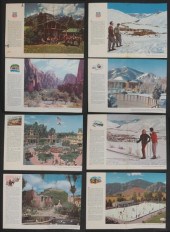 32 UNION PACIFIC RAILROAD DINING
32 UNION PACIFIC RAILROAD DINING CAR MENUS
32 UNION PACIFIC RAILROAD DINING
32 UNION PACIFIC RAILROAD DINING CAR MENUS -
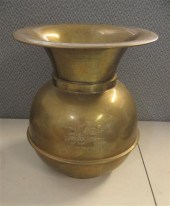 Union Pacific Rail Road brass
Union Pacific Rail Road brass spitoon
Union Pacific Rail Road brass
Union Pacific Rail Road brass spitoon -
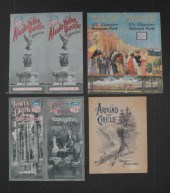 17 PIECES UNION PACIFIC EPHEMERA
17 PIECES UNION PACIFIC EPHEMERA BACK TO 1904 WF
17 PIECES UNION PACIFIC EPHEMERA
17 PIECES UNION PACIFIC EPHEMERA BACK TO 1904 WF -
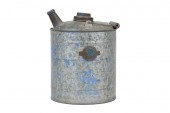 UNION PACIFIC OIL CAN11 1/4
UNION PACIFIC OIL CAN11 1/4 inches high Condition:
UNION PACIFIC OIL CAN11 1/4
UNION PACIFIC OIL CAN11 1/4 inches high Condition: -
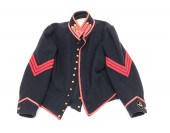 UNION SERGEANT REENACTMENT
UNION SERGEANT REENACTMENT UNIFORM Late 20th century, wool. Short jacket and vest with embossed eagle brass buttons.
UNION SERGEANT REENACTMENT
UNION SERGEANT REENACTMENT UNIFORM Late 20th century, wool. Short jacket and vest with embossed eagle brass buttons. -
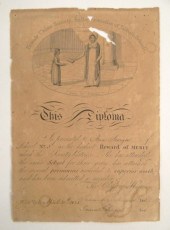 1825 Female Union Society
1825 Female Union Society Brooklyn New York diploma.
1825 Female Union Society
1825 Female Union Society Brooklyn New York diploma. -
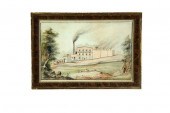 UNION STARCH FACTORY (AMERICAN
UNION STARCH FACTORY (AMERICAN 2ND-HALF 19TH CENTURY). Watercolor on paper unsigned. Period frame 14 1/2''h. 20 3/4''w. Ex David Good (Ohio). According to a note on the back ''Samuel Cutsinger and two other men established ''Blue River Starch Works in 1868 in Johnson Company Indiana. Forerunner of the ''Union Starch and Refining Company in operation as late as 1885''.
UNION STARCH FACTORY (AMERICAN
UNION STARCH FACTORY (AMERICAN 2ND-HALF 19TH CENTURY). Watercolor on paper unsigned. Period frame 14 1/2''h. 20 3/4''w. Ex David Good (Ohio). According to a note on the back ''Samuel Cutsinger and two other men established ''Blue River Starch Works in 1868 in Johnson Company Indiana. Forerunner of the ''Union Starch and Refining Company in operation as late as 1885''. -
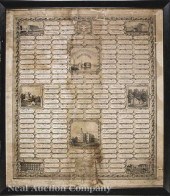 [Union War Prisoners Association]
[Union War Prisoners Association] "Union War Prisoners Association Organized in Charleston Jail Dec. 31st 1861" lithograph published by Goupil & Co. 1863 with soldiers names in cartouches and showing vignettes of the prisons in Richmond Columbia Salisbury Charleston and New Orleans 31 1/2 in. x 27 1/2 in. framed.
[Union War Prisoners Association]
[Union War Prisoners Association] "Union War Prisoners Association Organized in Charleston Jail Dec. 31st 1861" lithograph published by Goupil & Co. 1863 with soldiers names in cartouches and showing vignettes of the prisons in Richmond Columbia Salisbury Charleston and New Orleans 31 1/2 in. x 27 1/2 in. framed. -
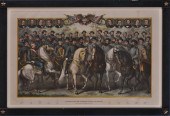 AMERICAN SCHOOL: PROMINENT UNION
AMERICAN SCHOOL: PROMINENT UNION AND CONFEDERATE GENERALS AND STATESMEN Color lithograph 26 1/4 x 40 in. (image) published by Kurz & allison.
AMERICAN SCHOOL: PROMINENT UNION
AMERICAN SCHOOL: PROMINENT UNION AND CONFEDERATE GENERALS AND STATESMEN Color lithograph 26 1/4 x 40 in. (image) published by Kurz & allison. -
 (2) lapel pins with enamel fronts
(2) lapel pins with enamel fronts ''Union Cycles'' (c.1891-1900) ''Falcon Cycles'' (c. 1895-1898). VG cond.
(2) lapel pins with enamel fronts
(2) lapel pins with enamel fronts ''Union Cycles'' (c.1891-1900) ''Falcon Cycles'' (c. 1895-1898). VG cond. -
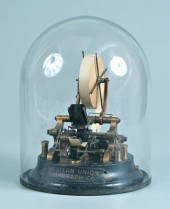 Western Union stock ticker,
Western Union stock ticker, Edison Universal type 3A, serial number 729, lacquered brass mechanism, base with original black paint and gilt "Western Union Telegraph Co." cartouche, 10 x 8-3/4 in., with original metal rimmed glass dome, 12 x 9-1/2 in.; lot accompanied by contemporary appraisal. Losses to black paint. Purchased from Western Union Company, in the 1950s by the consignor's grandfather, a Western Union lineman.
Western Union stock ticker,
Western Union stock ticker, Edison Universal type 3A, serial number 729, lacquered brass mechanism, base with original black paint and gilt "Western Union Telegraph Co." cartouche, 10 x 8-3/4 in., with original metal rimmed glass dome, 12 x 9-1/2 in.; lot accompanied by contemporary appraisal. Losses to black paint. Purchased from Western Union Company, in the 1950s by the consignor's grandfather, a Western Union lineman. -
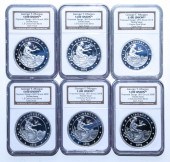 SIX - $100 UNIONS GEORGE MORGAN 1.5
SIX - $100 UNIONS GEORGE MORGAN 1.5 OZ NGC All certified and encapsulated by NGC as Gem Proof. A proposed design in 1876 that was never made - 9 ounces silver.
SIX - $100 UNIONS GEORGE MORGAN 1.5
SIX - $100 UNIONS GEORGE MORGAN 1.5 OZ NGC All certified and encapsulated by NGC as Gem Proof. A proposed design in 1876 that was never made - 9 ounces silver. -
 (2) LIONEL LOCOMOTIVE AND TANK -
(2) LIONEL LOCOMOTIVE AND TANK - UNION PACIFICIncluding Union Pacific Veranda Turbine (#6-18149) 20'' L and Auxiliary tender 10'' L both painted yellow/gray with red lettering commander control rail sounds and towercom lighted interior die-cast stamped metal frame smoke units electro couplers two Pittman motors new in original box. Private collection Metamora MI.
(2) LIONEL LOCOMOTIVE AND TANK -
(2) LIONEL LOCOMOTIVE AND TANK - UNION PACIFICIncluding Union Pacific Veranda Turbine (#6-18149) 20'' L and Auxiliary tender 10'' L both painted yellow/gray with red lettering commander control rail sounds and towercom lighted interior die-cast stamped metal frame smoke units electro couplers two Pittman motors new in original box. Private collection Metamora MI. -
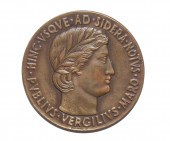 AMERICAN CLASSICAL LEAGUE 1930
AMERICAN CLASSICAL LEAGUE 1930 MEDAL A product of Medallic Art of NY in Bronze by TM Jones. The obverse has a classic figure with laurel wreath in their hair with the wording around the edge - "Hinc Usque ad Sidera notus Publius Vergilius Maro" The reverse has an inner circle with the American Classical League 1919 and the wording "Uestra Causa tota nostra est" (Your Cause is All Ours) and around the edge is "Bi millennium Uergilianum MCMXXX Nomenque Tuum Laudesque Manebunt Semper Honos" (Virgilian 1930 Your Name and Praises Will Always Be Honored."
AMERICAN CLASSICAL LEAGUE 1930
AMERICAN CLASSICAL LEAGUE 1930 MEDAL A product of Medallic Art of NY in Bronze by TM Jones. The obverse has a classic figure with laurel wreath in their hair with the wording around the edge - "Hinc Usque ad Sidera notus Publius Vergilius Maro" The reverse has an inner circle with the American Classical League 1919 and the wording "Uestra Causa tota nostra est" (Your Cause is All Ours) and around the edge is "Bi millennium Uergilianum MCMXXX Nomenque Tuum Laudesque Manebunt Semper Honos" (Virgilian 1930 Your Name and Praises Will Always Be Honored." -
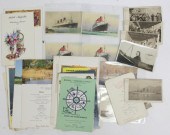 Fifteen Union Castle Line postcards
Fifteen Union Castle Line postcards various other postcards of liners menu cards and related material
Fifteen Union Castle Line postcards
Fifteen Union Castle Line postcards various other postcards of liners menu cards and related material
...many more examples with full details are available to our members - Learn more


